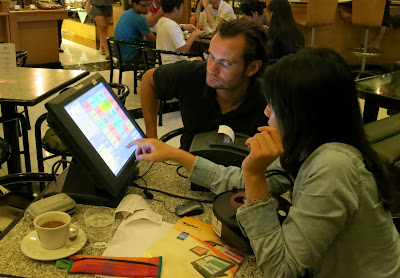Last week we met our contractors for the first time and they kept on asking us questions we had not yet thought of. One of the many was about the kitchen flooring. They recommended "epoxy" but before we said yes I, the tireless researcher, thought we better did some research before confirming our choice. This decision unexpectedly triggered a chain of field trips, meetings, findings and surprises that kept us busy for the week.
Our goal is finding a flooring solution that stands the test of time, resists chemicals, spills and stains, it is hygienic, easy to clean, anti-slip, affordable and looks good. Secondary research showed a few options which we narrowed down to three, and a deeper look into them proved that each had unique pros and cons. Let me enlighten you:
Epoxy quartz floor
It is applied in multiple steps. First a resin is painted on the floor, then quartz is broadcast into the resin. The dry quartz then soaks up much of the resin that would otherwise soak into the floor. After it cures, an epoxy is painted over the quartz.Pros: it is highly resistant, hygienic, exceptionally durable and soft on the feet.
Cons: it is quite expensive compared to the other options, it chips so it needs to be replaced periodically, it could be slippery and the biggest con of all, it requires a very long time to prepare both the surface and each layer, and extremely skillful labor, quite scarce here.
These are some of the scary consequences of a poorly applied epoxy flooring:
Tile
It is usually made out of natural clay and applied to the floor with a troweled-on cement based mortar.
Pros: it is comparatively inexpensive and easy to install, can be individually replaced and readily available.
Cons: it is very hard on the feet, it is a porous material so can easily grow bacteria (specially in the grout joints), it breaks quite easily both under impact or as water eventually goes through it and the grouts are very difficult to keep clean as grease, water and food particles get trapped.
Vinyl flooring
Pros: it is soft on the feet, it looks good when new and is cheap. Also it is quick and easy to both install and clean and it has high resilience to abrasion and impact damage.
Cons: it does not work very well at all under wet conditions. Almost always, the water gets underneath and the floor starts coming off.
Lost in these lists of advantages and disadvantages, we decided we needed to better understand our options in Bali so we visited several professional kitchens around the island to see what they were using and get their opinion. The outcome was a myriad of advice. Our decision would change every time we ended a conversation or faced the disturbing truth of a wrong choice.
Will keep you posted on our decision but as you can see, there is never a dull day in our adventures in Bali.
Lost in these lists of advantages and disadvantages, we decided we needed to better understand our options in Bali so we visited several professional kitchens around the island to see what they were using and get their opinion. The outcome was a myriad of advice. Our decision would change every time we ended a conversation or faced the disturbing truth of a wrong choice.
Will keep you posted on our decision but as you can see, there is never a dull day in our adventures in Bali.



















































